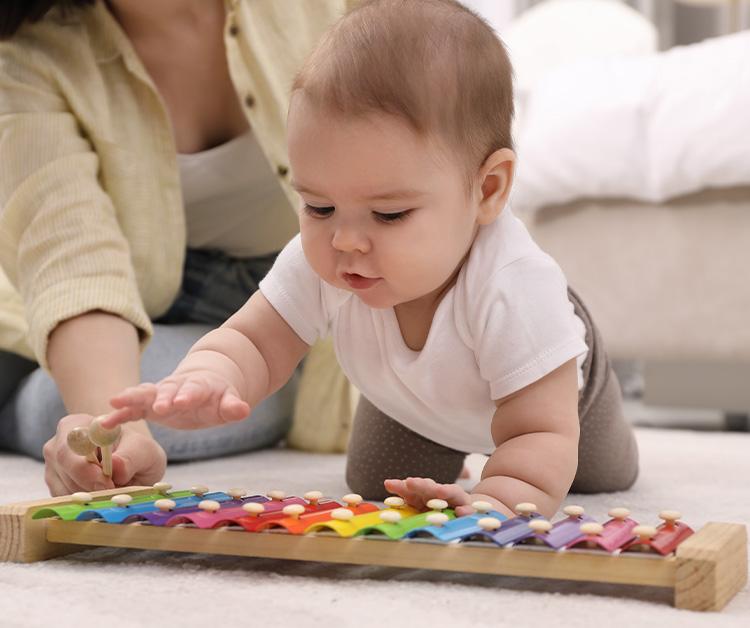Website maintenance scheduled Jan. 9-12; Rebates unavailable Jan. 5-20.

Here are some simple activities your five-month-old baby and you can do together to support your baby’s thinking, movements, and more.
Medically reviewed by a board-certified pediatrician
Eye tracking. You can help encourage your 5-month-old’s eye movements by holding a rattle in front of your baby’s face and moving it across their line of vision at different speeds. They’ll begin to follow and bat at the object even if their aim’s not quite accurate yet.
Making mirror connections. When you hold your baby in front of a mirror and look at your reflections together, while admiring what a cute pair you make, your little one will begin to notice that the people in the mirror are moving in the same way the two of you are.
Hide-and-seek. By covering a toy with a blanket and letting your baby search for it, you help teach them about object permanence—just because they can’t see it, doesn’t mean it’s gone for good. If they’re not quite ready to play this game yet, don’t worry! They’ll get there eventually.
Swapping toys. From time to time, switching the toys on your baby’s bouncy seat gives them something new to explore. Toys that squeak, rattle, or play music can be new and exciting. Wood or plastic blocks and rings are also good choices for your baby to handle. Try including toys of different shapes, sizes, and textures, such as smooth, bumpy, thin, and thick to give them something to explore with their hands and mouth.
Bouncing. By gently holding your baby in a sitting position on your lap while you bounce them provides a fun game for them, and good exercise too. Now that they have head and neck control, they’ll be ready to bounce and bounce, even when you’re all bounced out. It’s a simple and fun five-month-old activity.
Sitting. Helping them master the skill of sitting up can be done in little bits every day. Your baby might already sit on their own, supporting their body with their hands in front of them like a frog or tripod. If not, you can use cushions or a firm U-shaped pillow to help balance and support them in case they topple.
Exploring their feet. When you hold your baby upright with their feet touching the floor, they can feel their own weight on their feet. A whole new sensation!
Reaching. Intriguing toys placed slightly out of reach beside your baby while they’re on their tummy give them something to reach for. It gives you something to cheer for, too.
Grasping. A rattle in your baby’s hand encourages them to hold it. This practice helps them learn the feeling of weight and movement, even if they aren’t able to release it voluntarily just yet.
Narrating. When you narrate the events of your baby’s day to them while you feed, bathe, and change them, they begin to listen and learn.
Naming their world. Saying the names of the objects in your baby’s everyday world as they encounter a book, cat, bath, or high chair allows them to take it all in.
Singing. Whether a nursery rhyme or a pop song, words set to music helps your little one learn language. They won’t care whether you can carry a tune or not, so belt it out!
Reading. Whether it’s a few pages or just pointing out certain images and saying, “Look at the sun,” “Look at the flower,” “What’s this? A doggie!” you’re helping your baby begin to associate words with what they see.
Conversation. It’s fun to respond to your baby’s babbles. Especially when their noises become more complex, and sound more and more like words and sentences. Responding as if they’re using clear language engages your little one in a fun back-and-forth conversation, and it might be the only adult conversation you have all day.
Likes and dislikes. Does your baby have a favorite toy or game? Your baby’s personality will probably be more apparent now, which is an exciting development, so encourage this by bringing what they love into play.
Dance. When you hold your baby to dance or sway, the closeness fosters your baby’s sense of security, while your swaying body relaxes them.
Bedtime ritual. You can help teach your baby to settle into sleep on their own by singing to them more softly at bedtime than when you put them down for naps. Placing them on their back while they’re drowsy, but still awake, can also encourage them to calmly drift to sleep.
Of course, these activities for 5-month-olds aren’t the only things that help support their healthy development. In addition, let’s help ensure they get the daily nutrients they need like those found in Enfamil® Optimum™ infant formula.
All information on Enfamil, including but not limited to information about health, medical conditions, and nutrition, is intended for your general knowledge and is not a substitute for a healthcare professional's medical identification, advice, or management for specific medical conditions. You should seek medical care and consult your doctor or pediatrician for any specific health or nutrition issues. Never disregard professional medical advice or delay seeking medical treatment, care, or help because of information you have read on Enfamil.